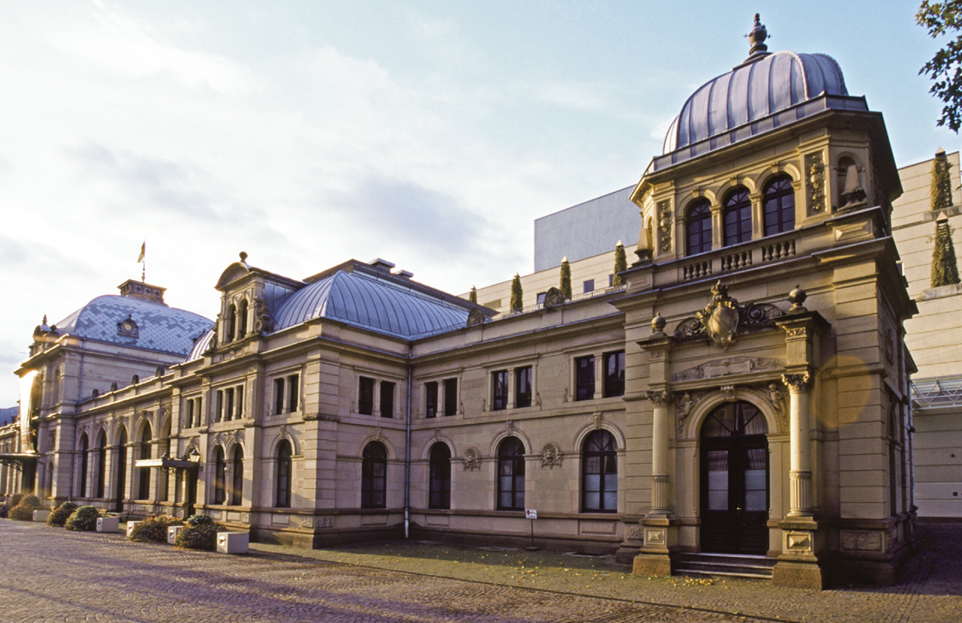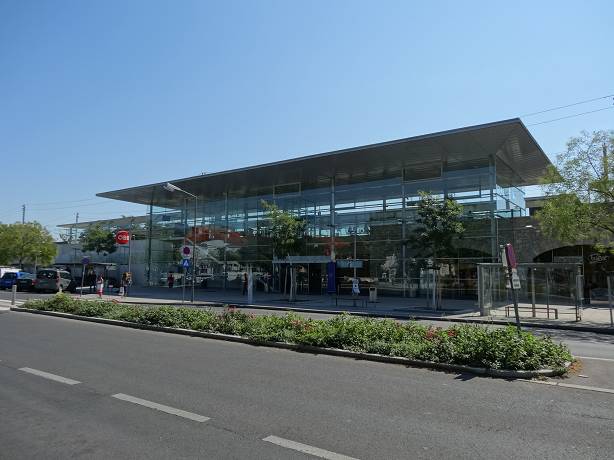Baden railway station
- Bözberg
I1i3i7i10i12i14i16i16i16i18i20
The Baden train station of the Swiss Federal Railways ( SBB) is the city's railway station Baden in the canton of Aargau. It was in 1847 as the terminus of the Swiss Northern Railway ( " Spanish Brötli -Bahn "), the first railway line in Switzerland opened, and is thus one of the oldest railway stations in the country. Designed by Ferdinand Stadler station building is the oldest in Switzerland, which has been preserved in its original state and is still used for railway operations. The Baden Train Station is located on the Bözberg SBB between Zurich and Basel and express support. Although branch off any routes, but he has especially used as a hub for numerous bus is of great importance.
Offer
It run - usually every half hour - fast trains to Basel, Bern, Zurich HB and to Zurich airport. In regional rail traffic Baden is the S23 and S27 of the S -Bahn Aargau as well as the S6 and S12 of the Zurich S-Bahn bedient.Stündlich runs the S23 via Brugg - Lenzburg - Aarau - Olten to Langenthal and every half hour the S27 through the lower Aare Valley to Koblenz and continued alternately to Waldshut respectively Zurzach. The Zurich S6 (Baden- Zurich Oerlikon - Zurich HB -mile Uetikon ) and the S12 ( Brugg -Baden Zurich HB-Winterthur-Seuzach/Seen ) run each half hour. In addition, keep twice daily City Night Line trains with coaches to Amsterdam CS, BerlinGesundbrunnen, Praha hl. n and Hamburg- Altona.
A special meaning does the Baden train station as a hub for bus services. Not less than 16 bus routes connect it to various destinations in the city and in the region. Eight lines of the Regional Public Transportation Baden- Wettingen ( RVBW ) pass through the station as transit lines. In addition, here is the terminus of eight postal bus lines that travel, especially during the rush hour in a tight clock. Aims of the Postal cars are Bellikon, Berikon - Widen, Bremgarten ( about Mellingen or Stetten ), emperor chair, Mägenwil and Tegerfelden. There are also several night bus lines. The Baden Bahnhof has a Mobility car sharing.
Plant
Although the stretch Zurich HB -Brugg the Bözberg generally runs from east to west. However, in the area of Baden the track has a South-North leaders, according to the station system is aligned. It consists of five through tracks with a house platform and two covered central platforms. The express trains usually on track 1 ( east ) or on track 3 ( westward ). Regional trains and S-Bahn trains use the tracks 2, 4 and 5
Under the railway station square there is the Metro Store, an underground shopping center. There are also the travel customer center of the SBB can be found, which was moved out of the station building ( the building itself now serves only as a restaurant and waiting room ). Other Services in Metro Store include a sales office of Western Union, a SBB travel agency and tourist office of the city of Baden.
Due to the high line and stroke density and the limited space of the bus has been unbundled and serves the station in the direction of operation. At the station square there is the bus station east, where the southward trains running RVBW buses stop. The bus station west of the goods road serves the northbound trains running RVBW buses and postal cars ( the latter, however, only to get off ). Start and end point of all postal routes is the mail car garage, north of the station is located directly under the main post office and has access to the Metro Store.
There are two tunnels: the first leads from the bus station west under the railway station through to the metro store and then to Badstrasse on the banks of the Limmat. It represents the most important pedestrian connection to the city in west-east direction and is continued in the form of a ridge over the Limmat after Ennetbaden. The second underpass located at the southern end of the track field shortly before the portal of the Kreuzlibergtunnels; near the old town it connects the Stadtturmstrasse with the Bahnhofstrasse.
Designed by Ferdinand Stadler station building has retained its basic structure until today. It consists of a two-story, stepped main building with excessive middle part, which is surrounded by projections. On the central ridge is resting upon four slender columns with clock tower and weather vane Blechhut. The main entrance is in the form of a tripartite round-arched arcade. Add to the main building on both sides in symmetrical, single storey side wing. Since 1995, the station is listed in the list of cultural goods of national importance.
History
Compared with neighboring countries, the railway era in Switzerland started relatively late. Reasons were topographical difficulties, but also the disunity of the cantons. 1838 a railway line was planned from Zurich to Basel along the rivers. In the Limmat valley Trassee should run on the right side of the valley, the Baden train station would have been built several hundred meters from the city on the Wettinger field. The project failed in December 1841, lack of money, the resistance of the rural population and for various political reasons.
1846, the Swiss Northern Railway (SNB ) was established finally after a long planning. She took on the old project, but with a line trailing from the left of the Limmat. The city of Baden hoped the SNB will also build a branch line through Lenzburg to Aarau. As the site of the station they preferred the area before the Mellingertor south of the old town. This, however, chief engineer Alois Negrelli disagreed. He convinced the city authorities of a railway station on the hazel field north of the center ( at the current location so ) would be better due to the flat terrain suitable and can be easily extended if required. In addition, the tourist attraction in bathing quarter will be better developed.
However, this change to the project made the construction of a 80 meter long tunnel under the castle hill and the ruins of stone required. To make room for the tunnel, the Powder Tower and part of the city wall had to be canceled. During construction of the Schlossberg tunnel first prisoners were used, later a laborer. A blasting accident claimed three lives, six more workers died of typhus. The tunnel puncture was performed on 14 April 1848. Meanwhile, according to the plans of architect Ferdinand Stadler a representative station building and goods shed were created.
On August 7, 1847, between Zurich and Baden, the first railway line lying entirely on Swiss territory, officially opened, the scheduled train operation began two days later. The track soon earned the nickname " Spanish Brötli train ," according to a native of Baden pastries Spanish Brötli, which at that time enjoyed great popularity in Zurich. The locomotives used in Baden on a turntable.
The continued construction of the route was delayed for several years because the new, founded in 1848, Swiss State first had yet to adopt the legal foundations for the railway system. In 1853 became the SNB in the Swiss Northeastern Railway (NOB ), which now advanced the planning. She let Zweigstrecke Baden- Lenzburg -Aarau (later built by the Swiss National Railway ) and which began in summer 1854 with the construction of the continuation of the existing line to Brugg ( with a branch at the intermediate station Turgi towards Waldshut ). The opening took place on 29 September 1856. Except for the electrification of the line Zurich - Olten on January 21, 1925 resulted in the following 100 years, no significant operational changes.
From the late 1940s the road in Baden began markedly increasing. The level of level crossings on the Stadtturmstrasse north and on the school playground south of the tunnel portal increasingly lead to bottlenecks; the barriers were closed every day for more than five hours. The initially planned relocation of the station to the school playground met with strong disapproval. Finally, the Grand Council of the Canton of Aargau was 1955, the " little train laying " the preference. This project called for the construction of the 988 m long Kreuzlibergtunnels which, starting from the train passes under the critical points. The construction lasted from 1957 to 1961, the old Schlossberg tunnel has since served the road.
In 1967, the first redesign of the station area. In five years of construction under the station square was the shopping arcade, Metro Store. In addition, the flows of pedestrians, automobile traffic and buses were unbundled. Since the Brown, Boveri & Cie. (now Asea Brown Boveri ), the north of the station an extensive industrial site owned, more and more manufacturing withdrew from the city center, the freight traffic declined significantly. 1988 formed SBB, post office, RVBW and the Building Department of the Canton of Aargau a Project Commission, which investigated the urban development opportunities around the station.
In 1998 the implementation of the winning design plan. In the same year more than 150 -year-old goods shed were demolished on the west side of the station and removed the tracks for freight. In their place, a building with shops and offices, the center (called the long house) and the bus station West, which is reached from the Schlossberg road tunnel from a ramp. The station building has undergone an extensive renovation, remodeled the Metro Store. A folk festival in September 2001 was the culmination of modernization. The Postbus Switzerland AG and the Association of Public Transport recorded in 2008 with the FLUX prize for particularly well-designed transportation hub the Baden train station.









